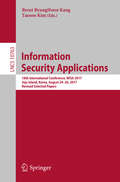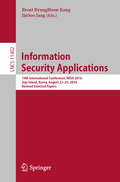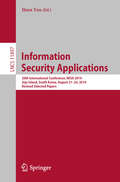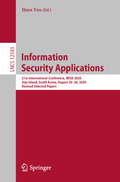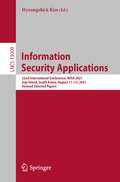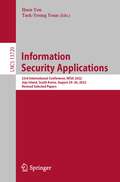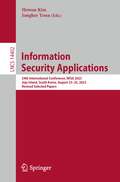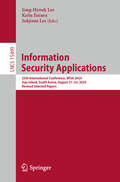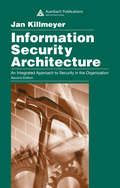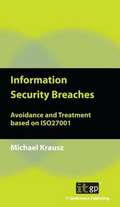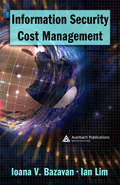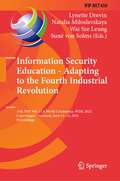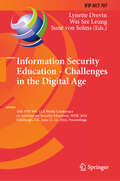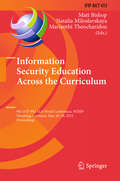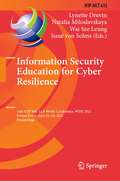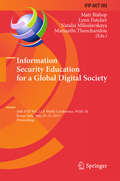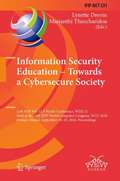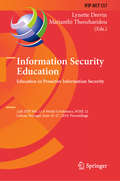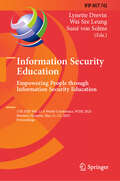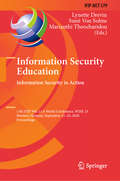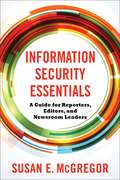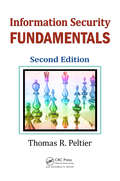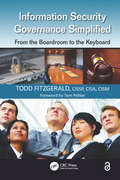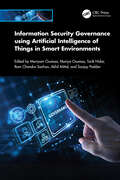- Table View
- List View
Information Security Applications: 18th International Conference, WISA 2017, Jeju Island, Korea, August 24-26, 2017, Revised Selected Papers (Lecture Notes in Computer Science #10763)
by Brent ByungHoon Kang Taesoo KimThis book constitutes the thoroughly refereed post-conference proceedings of the 18th International Conference on Information Security Applications, WISA 2017, held on Jeju Island, Korea, in August 2017.The 12 revised full papers and 15 short papers presented in this volume were carefully reviewed and selected from 53 submissions. The papers are organized in topical sections such as attack and defense; theory in security; web security and emerging technologies; systems security and authentication; crypto protocols; and attack detections and legal aspects.
Information Security Applications: 19th International Conference, Wisa 2018, Jeju Island, Korea, August 23-24, 2018, Revised Selected Papers (Lecture Notes in Computer Science #11402)
by Brent ByungHoon Kang JinSoo JangThis book constitutes the thoroughly refereed post-conference proceedings of the 19th International Conference on Information Security Applications, WISA 2018, held on Jeju Island, Korea, in August 2018. The 11 revised full papers and 11 short papers presented in this volume were carefully reviewed and selected from 44 submissions. #The primary focus of WISA 2018 was on systems and network security including all other technical and practical aspects of security applications and also on the embedded, unmanned or autonomous systems and cyber physical systems in general.
Information Security Applications: 20th International Conference, WISA 2019, Jeju Island, South Korea, August 21–24, 2019, Revised Selected Papers (Lecture Notes in Computer Science #11897)
by Ilsun YouThis book constitutes the thoroughly refereed post-conference proceedings of the 20th International Conference on Information Security Applications, WISA 2019, held on Jeju Island, South Korea, in August 2019. The 29 revised full papers presented in this volume were carefully reviewed and selected from 63 submissions. The primary focus of WISA 2019 was on systems and network security including all other technical and practical aspects of security application in general. The papers are grouped in the following topical sections: Application and Game Security; Network Security and Blockchain; Cryptography; Security with AI and Machine Learning; IoT Security; Hardware Security; and Selected Security Issues.
Information Security Applications: 21st International Conference, WISA 2020, Jeju Island, South Korea, August 26–28, 2020, Revised Selected Papers (Lecture Notes in Computer Science #12583)
by Ilsun YouThis book constitutes the thoroughly refereed proceedings of the 21st International Conference on Information Security Applications, WISA 2020, held in Jeju Island, South Korea, in August 2020. The 30 full research papers included in this book were carefully reviewed and selected from 89 submissions. They are organized in the following topical sections: AI Security and Intrusion Detection; Steganography and Malware; Application, System, and Hardware Security; Cryptography; Advances in Network Security and Attack Defense; and Cyber Security.
Information Security Applications: 22nd International Conference, WISA 2021, Jeju Island, South Korea, August 11–13, 2021, Revised Selected Papers (Lecture Notes in Computer Science #13009)
by Hyoungshick KimThis book constitutes the revised selected papers from the 22nd International Conference on Information Security Applications, WISA 2021, which took place on Jeju Island, South Korea, during August 2021. The 23 papers included in this book were carefully reviewed and selected from 66 submissions. They were organized in topical sections as follows: machine learning security; cryptography; hardware security; and application security.
Information Security Applications: 23rd International Conference, WISA 2022, Jeju Island, South Korea, August 24–26, 2022, Revised Selected Papers (Lecture Notes in Computer Science #13720)
by Ilsun You Taek-Young YounThis book constitutes the revised selected papers from the 23rd International Conference on Information Security Applications, WISA 2022, which took place on Jeju Island, South Korea, during August 2022.The 25 papers included in this book were carefully reviewed and selected from 76 submissions. They were organized in topical sections as follows: network security; cryptography; vulnerability analysis; privacy enhancing technique; security management; security engineering.
Information Security Applications: 24th International Conference, WISA 2023, Jeju Island, South Korea, August 23–25, 2023, Revised Selected Papers (Lecture Notes in Computer Science #14402)
by Howon Kim Jonghee YounThis book constitutes the revised selected papers from the 24th International Conference on Information Security Applications, WISA 2023, held in Jeju Island, South Korea, during August 23–25, 2023.The 25 papers included in this book were carefully reviewed and selected from 76 submissions. They were organized in topical sections as follows: Cryptography; network and application security; privacy and management; attacks and defenses; post-quantum cryptography and quantum cryptanalysis.
Information Security Applications: 25th International Conference, WISA 2024, Jeju Island, South Korea, August 21–23, 2024, Revised Selected Papers (Lecture Notes in Computer Science #15499)
by Jong-Hyouk Lee Keita Emura Sokjoon LeeThis book constitutes the refereed proceedings of the 25th International Conference on Information Security Applications, WISA 2024, held in Jeju Island, South Korea, during August 21–23, 2024. The 28 full papers included in this book were carefully reviewed and selected from 87 submissions. They were organized in topical sections as follows: Cryptography; Network Security; AI Security 1; Network & Application Security; AI Security 2; CPS Security; Fuzzing; Malware; Software Security; and Emerging Topic.
Information Security Architecture: An Integrated Approach to Security in the Organization, Second Edition
by Jan KillmeyerInformation Security Architecture, Second Edition incorporates the knowledge developed during the past decade that has pushed the information security life cycle from infancy to a more mature, understandable, and manageable state. It simplifies security by providing clear and organized methods and by guiding you to the most effective resources avai
Information Security Breaches: Avoidance and Treatment Based on ISO27001
by Michael KrauszWiden the horizon of your Information Security Knowledge!Although breaches of information security are not a new phenomenon, the methods used to perpetrate such breaches have changed considerably over the years. Leaking information to non-authorised people has always been an issue but, in the computer age, the speed and effectiveness with which breaches of information security can occur, and the amount of harm potentially caused are disturbing. Typically, also, they favour the perpetrator, not the victim. The process outlinedThis pocket guide outlines a process and its elements for the treatment of severe breaches, and places them in the context of the associated ISO27001 controls. It provides input for decision making and breach classification, and case studies where the reader can check out how other companies were affected and what they did, or did not do, upon becoming the victim of a breach. Intended to serve two purposes. . . Firstly, this title provides a general discussion of what information security breaches are, how they can be treated, and what ISO27001 offers in that respect, illustrated with details of real-life information security incidents. It aims to serve as a facilitator to widen the horizon of the reader seeking knowledge, or as an introduction for those who arejust starting to think about information security. Secondly, it will form a first line of defence for the reader who is the victim of an incident and is looking for guidance and direction. Here, it will help the reader by identifying, discussing and evaluating treatment options and, through the case studies, it will reduce the tension of the situation readers may find themselves in once abreach occurs. The audienceThis guide is aimed at CSOs, CISOs, IT Security Managers, CIOs and, last but not least, CEOs. It particularly addresses personnel in non-IT roles, in an effort to make this unwieldy subject more comprehensible to those who, in a worst-case scenario, will be on the receiving end of requests for six- or seven-figure excess budgets to copewith severe incidents.
Information Security Cost Management
by Ian Lim Ioana V. BazavanWhile information security is an ever-present challenge for all types of organizations today, most focus on providing security without addressing the necessities of staff, time, or budget in a practical manner.Information Security Cost Management offers a pragmatic approach to implementing information security, taking budgetary and real
Information Security Education - Adapting to the Fourth Industrial Revolution: 15th IFIP WG 11.8 World Conference, WISE 2022, Copenhagen, Denmark, June 13–15, 2022, Proceedings (IFIP Advances in Information and Communication Technology #650)
by Natalia Miloslavskaya Lynette Drevin Suné Von Solms Wai Sze LeungThis book constitutes the refereed proceedings of the 15th IFIP WG 11.8 World Conference on Information Security Education, WISE 2022, held in Copenhagen, Denmark, in June 2021. The 8 papers presented were carefully reviewed and selected from 17 submissions. The papers are categorized into the following topical sub-headings: Securing the Fourth Industrial Revolution through Programming; Cybersecurity in the Fourth Industrial Revolution: Charting the Way Forward in Education; and Real-World Cybersecurity-Inspired Capacity Building.
Information Security Education - Challenges in the Digital Age: 16th IFIP WG 11.8 World Conference on Information Security Education, WISE 2024, Edinburgh, UK, June 12–14, 2024, Proceedings (IFIP Advances in Information and Communication Technology #707)
by Lynette Drevin Suné Von Solms Wai Sze LeungThis book constitutes the refereed proceedings of the 16th IFIP WG 11.8 World Conference on Information Security Education on Information Security Education Challenges in the Digital Age, WISE 2024, held in Edinburgh, UK, during June 12–14, 2024. The 13 papers presented were carefully reviewed and selected from 23 submissions. The papers are organized in the following topical sections: cybersecurity training and education; enhancing awareness; digital forensics and investigation; cybersecurity programs and career development.
Information Security Education Across the Curriculum
by Matt Bishop Natalia Miloslavskaya Marianthi TheocharidouThis book constitutes the refereed proceedings of the 9th IFIP WG 11. 8 World Conference on Security Education, WISE 9, held in Hamburg, Germany, in May 2015. The 11 revised papers presented together with 2 invited papers were carefully reviewed and selected from 20 submissions. They are organized in topical sections on innovative methods, software security education, tools and applications for teaching, and syllabus design.
Information Security Education Across the Curriculum: 9th IFIP WG 11.8 World Conference, WISE 9, Hamburg, Germany, May 26-28, 2015, Proceedings (IFIP Advances in Information and Communication Technology #453)
by Matt Bishop Natalia Miloslavskaya Marianthi TheocharidouThis book constitutes the refereed proceedings of the 9th IFIP WG 11.8 World Conference on Security Education, WISE 9, held in Hamburg, Germany, in May 2015. The 11 revised papers presented together with 2 invited papers were carefully reviewed and selected from 20 submissions. They are organized in topical sections on innovative methods, software security education, tools and applications for teaching, and syllabus design.
Information Security Education for Cyber Resilience: 14th IFIP WG 11.8 World Conference, WISE 2021, Virtual Event, June 22–24, 2021, Proceedings (IFIP Advances in Information and Communication Technology #615)
by Natalia Miloslavskaya Lynette Drevin Suné Von Solms Wai Sze LeungThis book constitutes the refereed proceedings of the 14th IFIP WG 11.8 World Conference on Information Security Education, WISE 14, held virtually in June 2021.The 8 papers presented together with a special chapter showcasing the history of WISE and two workshop papers were carefully reviewed and selected from 19 submissions. The papers are organized in the following topical sections: a roadmap for building resilience; innovation in curricula; teaching methods and tools; and end-user security.
Information Security Education for a Global Digital Society
by Matt Bishop Natalia Miloslavskaya Marianthi Theocharidou Lynn FutcherThis book constitutes the refereed proceedings of the 10th IFIP WG 11. 8 World Conference on Security Education, WISE 10, held in Rome, Italy, in May 2017. The 14 revised papers presented were carefully reviewed and selected from 31 submissions. They represent a cross section of applicable research as well as case studies in security education and are organized in the following topical sections: information security education; teaching information security; information security awareness and culture; and training information security professionals. .
Information Security Education – Towards a Cybersecure Society: 11th IFIP WG 11.8 World Conference, WISE 11, Held at the 24th IFIP World Computer Congress, WCC 2018, Poznan, Poland, September 18–20, 2018, Proceedings (IFIP Advances in Information and Communication Technology #531)
by Marianthi Theocharidou Lynette DrevinThis book constitutes the refereed proceedings of the 11th IFIP WG 11.8 World Conference on Information Security Education, WISE 11, held at the 24th IFIP World Computer Congress, WCC 2018, in Poznan, Poland, in September 2018.The 11 revised papers presented were carefully reviewed and selected from 25 submissions. They focus on cybersecurity and are organized in the following topical sections: information security learning techniques; information security training and awareness; and information security courses and curricula.
Information Security Education. Education in Proactive Information Security: 12th IFIP WG 11.8 World Conference, WISE 12, Lisbon, Portugal, June 25–27, 2019, Proceedings (IFIP Advances in Information and Communication Technology #557)
by Marianthi Theocharidou Lynette DrevinThis book constitutes the refereed proceedings of the 11th IFIP WG 11.8 World Conference on Information Security Education, WISE 12, held in Lisbon, Portugal, in June 2019.The 12 revised full papers presented were carefully reviewed and selected from 26 submissions. The papers are organized in the following topical sections: innovation in curricula; training; applications and cryptography; and organizational aspects.
Information Security Education. Empowering People Through Information Security Education: 17th IFIP WG 11.8 World Conference, WISE 2025, Maribor, Slovenia, May 21–23, 2025, Proceedings (IFIP Advances in Information and Communication Technology #742)
by Lynette Drevin Suné Von Solms Wai Sze LeungThis book constitutes the refereed proceedings of the 17th IFIP WG 11.8 World Conference on Information Security Education, WISE 2025, held in Maribor, Slovenia, during May 21–23, 2025.The 13 full papers presented were carefully reviewed and selected from 30 submissions. The papers are organized in the following topical sections: Workforce and Curriculum Development; Curriculum and Research Development; Gamification in Cybersecurity Education; Innovative Approaches to Cybersecurity Awareness; Papers Invited from SEC; and Discussions.
Information Security Education. Information Security in Action: 13th IFIP WG 11.8 World Conference, WISE 13, Maribor, Slovenia, September 21–23, 2020, Proceedings (IFIP Advances in Information and Communication Technology #579)
by Marianthi Theocharidou Lynette Drevin Suné Von SolmsThis book constitutes the refereed proceedings of the 13th IFIP WG 11.8 World Conference on Information Security Education, WISE 13, held in Maribor, Slovenia, in September 2020. The conference was held virtually due to the COVID-19 pandemic. The 13 full papers presented were carefully reviewed and selected from 28 submissions. The papers are organized in the following topical sections: teaching methods and tools; cybersecurity knowledge within the organization; and teaching of detection and forensics.
Information Security Essentials: A Guide for Reporters, Editors, and Newsroom Leaders
by Susan E. McGregorAs technological and legal changes have hollowed out the protections that reporters and news organizations have depended upon for decades, information security concerns facing journalists as they report, produce, and disseminate the news have only intensified. From source prosecutions to physical attacks and online harassment, the last two decades have seen a dramatic increase in the risks faced by journalists at all levels even as the media industry confronts drastic cutbacks in budgets and staff. As a result, few professional or aspiring journalists have a comprehensive understanding of what is required to keep their sources, stories, colleagues, and reputations safe.This book is an essential guide to protecting news writers, sources, and organizations in the digital era. Susan E. McGregor provides a systematic understanding of the key technical, legal, and conceptual issues that anyone teaching, studying, or practicing journalism should know. Bringing together expert insights from both leading academics and security professionals who work at and with news organizations from BuzzFeed to the Associated Press, she lays out key principles and approaches for building information security into journalistic practice. McGregor draws on firsthand experience as a Wall Street Journal staffer, followed by a decade of researching, testing, and developing information security tools and practices. Filled with practical but evergreen advice that can enhance the security and efficacy of everything from daily beat reporting to long-term investigative projects, Information Security Essentials is a vital tool for journalists at all levels.
Information Security Fundamentals
by Thomas R. PeltierDeveloping an information security program that adheres to the principle of security as a business enabler must be the first step in an enterprise's effort to build an effective security program. Following in the footsteps of its bestselling predecessor, Information Security Fundamentals, Second Edition provides information security professionals w
Information Security Governance Simplified: From the Boardroom to the Keyboard
by Todd FitzgeraldSecurity practitioners must be able to build a cost-effective security program while at the same time meet the requirements of government regulations. This book lays out these regulations in simple terms and explains how to use the control frameworks to build an effective information security program and governance structure. It discusses how organizations can best ensure that the information is protected and examines all positions from the board of directors to the end user, delineating the role each plays in protecting the security of the organization.
Information Security Governance using Artificial Intelligence of Things in Smart Environments
by Mariya Ouaissa Mariyam Ouaissa Tarik Hidar Ram Chandra Sachan Akhil Mittal Sanjay PoddarThis book explores the integration of Artificial Intelligence (AI) with the Internet of Things (IoT) to address security challenges in smart environments. It delves into how AI enhances the governance of information security by automating processes, detecting threats, and ensuring the protection of data in interconnected IoT systems. It covers theoretical foundations, practical frameworks, and case studies, offering insights into securing smart cities, homes, industries, and healthcare systems. It also emphasizes governance models that leverage AI to manage security policies and risk in dynamic, data-driven ecosystems.This title focuses on the study and application of AI of Things in the field of information security governance. Intelligent environments, characterized by increasing connectivity of devices and systems, present unique challenges for information security. The use of AI of Things offers opportunities to enhance security in these complex environments.
